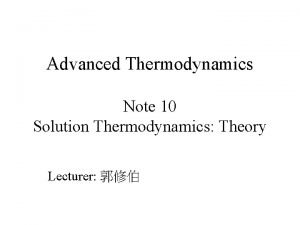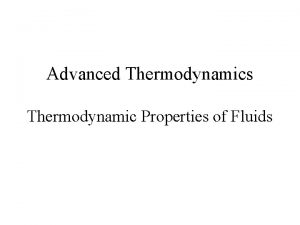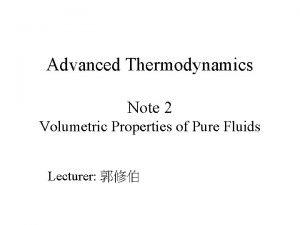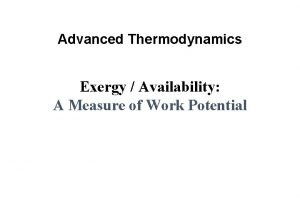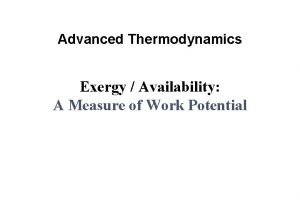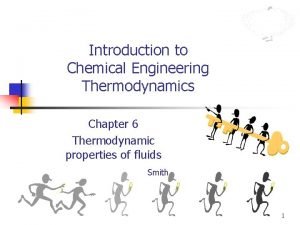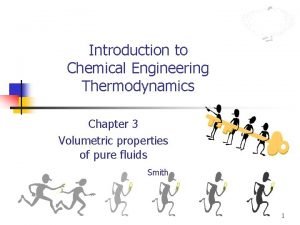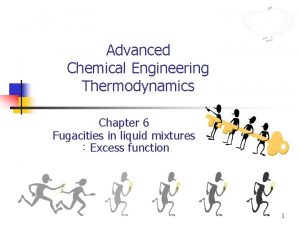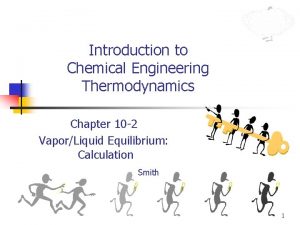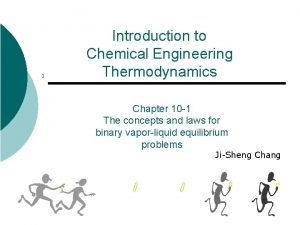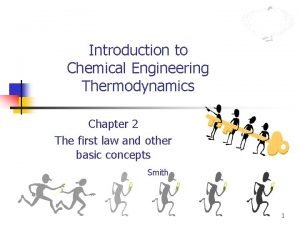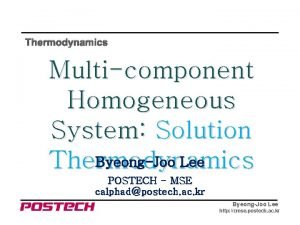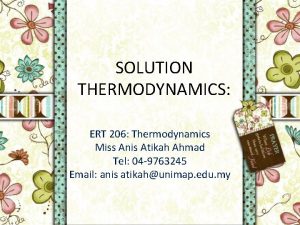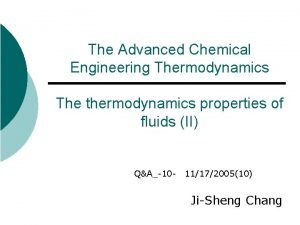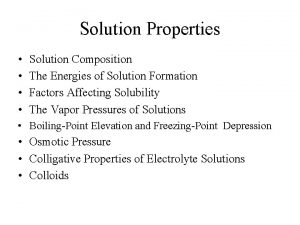Advanced Thermodynamics Note 10 Solution Thermodynamics Theory Lecturer








































- Slides: 40

Advanced Thermodynamics Note 10 Solution Thermodynamics: Theory Lecturer: 郭修伯

Compositions • Real system usually contains a mixture of fluid. • Develop theoretical foundation for applications of thermodynamics to gas mixtures and liquid solutions • Introducing – – – chemical potential partial properties fugacity excess properties ideal solution

Fundamental property relation • The basic relation connecting the Gibbs energy to the temperature and pressure in any closed system: – applied to a single-phase fluid in a closed system wherein no chemical reactions occur. • Consider a single-phase, open system:

Define the chemical potential: The fundamental property relation for single-phase fluid systems of constant or variable composition: When n = 1, Solution properties, M Partial properties, Pure-species properties, Mi The Gibbs energy is expressed as a function of its canonical variables.

Chemical potential and phase equilibria • Consider a closed system consisting of two phases in equilibrium: Mass balance: Multiple phases at the same T and P are in equilibrium when chemical potential of each species is the same in all phases.

Partial properties • Define the partial molar property of species i: – the chemical potential and the particle molar Gibbs energy are identical: – for thermodynamic property M:

and The Gibbs/Duhem equation Calculation of mixture properties from partial properties

Partial properties in binary solution • For binary system Const. P and T, using Gibbs/Duhem equation

The need arises in a laboratory for 2000 cm 3 of an antifreeze solution consisting of 30 mol-% methanol in water. What volumes of pure methanol and of pure water at 25°C must be mixed to form the 2000 cm 3 of antifreeze at 25°C? The partial and pure molar volumes are given. Fig 11. 2

Fig 11. 2

The enthalpy of a binary liquid system of species 1 and 2 at fixed T and P is: Determine expressions for and as functions of x 1, numerical values for the pure -species enthalpies H 1 and H 2, and numerical values for the partial enthalpies at infinite dilution and

Relations among partial properties • Maxwell relation:

Ideal-gas mixture • Gibbs’s theorem – A partial molar property (other than volume) of a constituent species in an ideal-gas mixture is equal to the corresponding molar property of the species as a pure ideal gas at the mixture temperature but at a pressure equal to its partial pressure in the mixture.

For those independent of pressure, e. g. , For those depend on pressure, e. g. , or From integration of

Fugacity and fugacity coefficient • Chemical potential: – provides fundamental criterion for phase equilibria – however, the Gibbs energy, hence μi, is defined in relation to the internal energy and entropy - (absolute values are unknown). • Fugacity: – a quantity that takes the place of μi With units of pressure

Residual Gibbs energy Fugacity coefficient

VLE for pure species • Saturated vapor: • Saturated liquid: VLE For a pure species coexisting liquid and vapor phases are in equilibrium when they have the same temperature, pressure, fugacity and fugacity coefficient.

Fugacity of a pure liquid • The fugacity of pure species i as a compressed liquid: Since Vi is a weak function of P

For H 2 O at a temperature of 300°C and for pressures up to 10, 000 k. Pa (100 bar) calculate values of fi and φi from data in the steam tables and plot them vs. P. For a state at P: For a low pressure reference state: The low pressure (say 1 k. Pa) at 300°C: For different values of P up to the saturated pressure at 300°C, one obtains the values of fi , and hence φi. Note, values of fi and φi at 8592. 7 k. Pa are obtained Values of fi andφi at higher pressure: Fig 11. 3

Fig 11. 3

Fugacity and fugacity coefficient: species in solution • For species i in a mixture of real gases or in a solution of liquids: Fugacity of species i in solution (replacing the particle pressure) • Multiple phases at the same T and P are in equilibrium when the fugacity of each constituent species is the same in all phases:

The residual property: The partial residual property: For ideal gas, The fugacity coefficient of species i in solution

Fundamental residual-property relation G/RT as a function of its canonical variables allows evaluation of all othermodynamic properties, and implicitly contains complete property information. The residual properties: or

Fix T and composition: Fix P and composition: Fix T and P:

Develop a general equation for calculation of factor data. values form compressibility- Integration at constant temperature and composition

Fugacity coefficient from the virial E. O. S • The virial equation: – the mixture second virial coefficient B: – for a binary mixture: • n mol of gas mixture:

Similarly: For multicomponent gas mixture, the general form: where

Determine the fugacity coefficients for nitrogen and methane in N 2(1)/CH 4(2) mixture at 200 K and 30 bar if the mixture contains 40 mol-% N 2.

Generalized correlations for the fugacity coefficient For pure gas or with For pure gas Table E 1: E 4 or Table E 13: E 16

Estimate a value for the fugacity of 1 -butene vapor at 200°C and 70 bar. and Table E 15 and E 16 For gas mixture: Empirical interaction parameter Prausnitz et al. 1986

Estimate and for an equimolar mixture of methyl ketone (1) / toluene (2) at 50°C and 25 k. Pa. Set all kij = 0.

The ideal solution • Serves as a standard to be compared: cf.

The Lewis/Randall Rule • For a special case of species i in an ideal solution: The Lewis/Randall rule The fugacity coefficient of species i in an ideal solution is equal to the fugacity coefficient of pure species i in the same physical state as the solution and at the same T and P.

Excess properties • The mathematical formalism of excess properties is analogous to that of the residual properties: – where M represents the molar (or unit-mass) value of any extensive thermodynamic property (e. g. , V, U, H, S, G, etc. ) – Similarly, we have: The fundamental excess-property relation

Table 11. 1

(1) If CEP is a constant, independent of T, find expression for GE, SE, and HE as functions of T. (2) From the equations developed in part (1), fine values for GE , SE, and HE for an equilmolar solution of benzene(1) / n-hexane(2) at 323. 15 K, given the following excess-property values for equilmolar solution at 298. 15 K: CEP =-2. 86 J/mol-K, HE = 897. 9 J/mol, and GE = 384. 5 J/mol From Table 11. 1: integration We have values of a, b, c and hence the excessproperties at 323. 15 K

The excess Gibbs energy and the activity coefficient • The excess Gibbs energy is of particular interest: The activity coefficient of species i in solution. A factor introduced into Raoult’s law to account for liquid-phase non-idealities. For ideal solution, c. f.

Experimental accessible values: activity coefficients from VLE data, VE and HE values come from mixing experiments. Important application in phase-equilibrium thermodynamics.

The nature of excess properties • GE: through reduction of VLE data • HE: from mixing experiment • SE = (HE - GE) / T • Fig 11. 4 – excess properties become zero as either species ~ 1. – GE is approximately parabolic in shape; HE and TSE exhibit individual composition dependence. – The extreme value of ME often occurs near the equilmolar composition.

Fig 11. 4
 Lecturer's name
Lecturer's name Advanced thermodynamics
Advanced thermodynamics Physician associate lecturer
Physician associate lecturer Spe distinguished lecturer
Spe distinguished lecturer Good morning teacher good morning teacher
Good morning teacher good morning teacher Photography lecturer
Photography lecturer Lecturer in charge
Lecturer in charge Designation lecturer
Designation lecturer Designation of lecturer
Designation of lecturer Guest lecturer in geography
Guest lecturer in geography Lecturer name
Lecturer name Pearson lecturer resources
Pearson lecturer resources 140000/120
140000/120 Lector vs lecturer
Lector vs lecturer Lecturer in charge
Lecturer in charge Cfa lecturer handbook
Cfa lecturer handbook Lecturer asad ali
Lecturer asad ali Residual properties thermodynamics
Residual properties thermodynamics Lee kesler equation
Lee kesler equation Exergy formula
Exergy formula Availability in thermodynamics
Availability in thermodynamics Difference between note making and note taking
Difference between note making and note taking Signal word
Signal word Difference between note making and note taking
Difference between note making and note taking Goods received note vs delivery note
Goods received note vs delivery note Debit note
Debit note Debit memo
Debit memo Note taking definition
Note taking definition Loan x has a principal of $10 000x
Loan x has a principal of $10 000x Chapter 6
Chapter 6 Chemical engineering thermodynamics 8th solution chapter 3
Chemical engineering thermodynamics 8th solution chapter 3 Thermodynamics for chemical engineering
Thermodynamics for chemical engineering Chapter 6
Chapter 6 Chemical engineering thermodynamics 8th solution chapter 10
Chemical engineering thermodynamics 8th solution chapter 10 Thermodynamics for chemical engineering
Thermodynamics for chemical engineering Introduction to chemical engineering thermodynamics
Introduction to chemical engineering thermodynamics Ideal solution thermodynamics
Ideal solution thermodynamics Is2000 the advanced imaging solution
Is2000 the advanced imaging solution Partial vapour pressure
Partial vapour pressure A remarkable turnaround case study
A remarkable turnaround case study Continental drift
Continental drift

